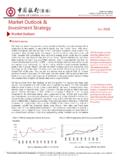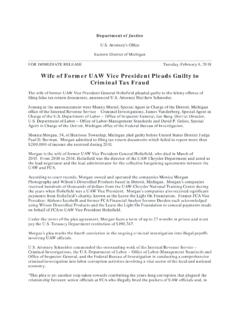Transcription of Administrative, Procedural, and Miscellaneous - …
1 Administrative, Procedural, and Miscellaneous 26 CFR : Changes in accounting periods and method of accounting. (Also: Part I, Sections 446, 451; ) Rev. Proc. 2018-29 SECTION 1. PURPOSE This revenue procedure provides new procedures for taxpayers changing their method of accounting for the recognition of income for federal income tax purposes to a method for recognizing revenues described in the new financial accounting standards issued by the Financial Accounting Standards Board (FASB) and the International Accounting Standards Board (IASB) (New Standards). In particular, this revenue procedure modifies Rev. Proc. 2017-30, 2017-18 1131, to provide procedures under 446 of the Internal Revenue Code (Code) and (e) of the Income Tax Regulations to obtain automatic consent of the Commissioner of Internal Revenue (Commissioner) to change to an otherwise permissible method of accounting that uses the New Standards to identify performance obligations, allocate transaction price to performance obligations, and/or consider performance obligations satisfied, if such 2 method change is made for the taxable year in which the taxpayer adopts the New Standards.
2 This revenue procedure does not provide guidance relating to the amendments to 451 made by section 13221 of An Act to provide for reconciliation pursuant to titles II and V of the concurrent resolution on the budget for fiscal year 2018, Pub. L. No. 115-97 (December 22, 2017) (the Act). The Department of the Treasury (Treasury Department) and the Internal Revenue Service (Service) are preparing additional guidance to address the amendments to 451 made by section 13221 of the Act. SECTION 2. BACKGROUND .01 On May 28, 2014, FASB and IASB jointly announced new financial accounting standards for revenue recognition, titled Revenue from Contracts with Customers (Topic 606). See FASB Update No. 2014-09 and IASB International Financial Reporting Standard (IFRS) 15..02 Publicly-traded entities, certain not-for-profit entities, and certain employee benefit plans are required to adopt the New Standards for annual reporting periods beginning after December 15, 2017.
3 All other entities are required to adopt the New Standards for annual reporting periods beginning after December 15, 2018. Early adoption is allowed for reporting periods beginning after December 15, 2016. See FASB Update No. 2015-14, Revenue from Contracts with Customers (Topic 606), Deferral of the Effective Date..03 Since the joint announcement, FASB and IASB have revised the New Standards and provided guidance on how to implement the New Standards in certain situations. See FASB Update No. 2015-14; FASB Update No. 2016-8, Revenue from Contracts 3 with Customers (Topic 606): Principal versus Agent Considerations (Reporting Revenue Gross versus Net); FASB Update No. 2016-10, Revenue from Contracts with Customers (Topic 606), Identifying Performance Obligations and Licensing; FASB Update No. 2016-12, Revenue from Contracts with Customers (Topic 606): Narrow-Scope Improvements and Practical Expedients; FASB Update No.
4 2017-13, Revenue Recognition (Topic 605), Revenue from Contracts with Customers (Topic 606), Leases (Topic 840), and Leases (Topic 842): Amendments to SEC Paragraphs Pursuant to the Staff Announcement at the July 20, 2017 EITF Meeting and Rescission of Prior SEC Staff Announcements and Observer Comments (SEC Update); FASB Update No. 2017-14, Income Statement Reporting Comprehensive Income (Topic 220), Revenue Recognition (Topic 605), and Revenue from Contracts with Customers) (Topic 606) (SEC Update)..04 Under the New Standards, an entity will recognize revenue for promised goods and services to customers in an amount that reflects the consideration to which the entity expects to be entitled in exchange for those goods and services based on the following five sequential steps: (i) identify the contracts with a customer; (ii) identify the performance obligations in the contract; (iii) determine the transaction price; (iv) allocate the transaction price to the performance obligations; and (v) recognize revenue as the entity satisfies a performance obligation.
5 05 On March 28, 2017, the Treasury Department and the Service issued Notice 2017-17, 2017-15 1073, containing, and inviting comments on, a proposed revenue procedure by which a taxpayer could request consent to change a method of accounting for recognizing income when the change is made for the same taxable year 4 in which the taxpayer adopts the New Standards and the change is made as a result of, or directly related to, the adoption of the New Standards..06 Commenters to Notice 2017-17 noted that the New Standards would affect taxpayers in the technology and construction industries and service providers with warranty and repair service contracts. Many of these taxpayers will have to accelerate income on their financial statements due to the New Standards, potentially creating a larger book-tax disparity. Commenters requested that the Service issue guidance to allow for more book-tax conformity and to allow taxpayers to easily file accounting method change requests associated with adopting the New Standards.
6 More specifically, commenters requested an expansion of current automatic accounting method change procedures, guidance on the recognition of advance payments, an expansion of the small business exception in the proposed revenue procedure in Notice 2017-17, and the option of implementing an accounting method change on either a cut-off basis or with a 481(a) adjustment..07 In this revenue procedure, the Treasury Department and the Service adopt certain of the suggestions submitted by commenters in response to Notice 2017-17. For example, this revenue procedure allows for more book-tax conformity and allows taxpayers to easily file accounting method change requests associated with adopting the New Standards. Specifically, this revenue procedure creates new automatic accounting method change procedures, applies rules similar to the small business exception in the proposed revenue procedure in Notice 2017-17 to more taxpayers, and provides taxpayers the option of implementing the accounting method change on either a cut-off basis or with a 481(a) adjustment.
7 Other comments, such as comments 5 requesting guidance on the recognition of advance payments, will be considered in connection with the issuance of guidance implementing the amendments made to 451 by the Act. The Treasury Department and the Service intend to provide additional guidance on these issues if needed to improve the procedures contained in this revenue procedure once the Treasury Department, the Service, and taxpayers obtain more experience with the interaction of the New Standards with federal income tax accounting methods..08 Section 13221 of the Act amends 451 by redesignating 451(b) through (i) as (d) through (k), and adding new 451(b) and (c). New 451(b) and (c) are effective for tax years beginning after December 31, 2017. Section 451(b), as amended by the Act, generally provides that for an accrual method taxpayer, the all events test with respect to any item of gross income (or portion thereof) shall not be treated as met any later than when such item (or portion thereof) is taken into account as revenue in an applicable financial statement of the taxpayer, or such other financial statement as the Secretary may specify.
8 However, new 451(b) is inapplicable to certain taxpayers, such as taxpayers that do not have an applicable financial statement or other financial statement specified by the Secretary. New section 451(c) provides an elective method of accounting for an accrual method taxpayer that receives an advance payment during the taxable year..09 The Treasury Department and the Service expect to provide guidance in the future to assist taxpayers in complying with amended 451..10 This revenue procedure is not intended to provide guidance for taxpayers changing their method of accounting to comply with amended 451. Rather, this 6 revenue procedure provides guidance for taxpayers changing a method of accounting to an otherwise permissible method of accounting that recognizes revenue in income in a manner described in the New Standards. For example, this revenue procedure provides procedures under which a taxpayer that has adopted the New Standards may make a corresponding change in its method of accounting for federal income tax purposes, provided the new method of accounting is otherwise permissible under the Code including under amended 451.
9 11 After considering the comments received on Notice 2017-17 and to reduce compliance costs, burden, and administrative complexity, the Treasury Department and the Service are issuing this revenue procedure to provide procedures under 446 and (e) for a taxpayer to obtain automatic consent of the Commissioner to change a method of accounting used to recognize income for federal income tax purposes to a method in which the taxpayer uses the New Standards to identify performance obligations, to allocate transaction price to performance obligations, and/or to consider performance obligations satisfied..12 This revenue procedure requests comments on future guidance that may be necessary as taxpayers begin to comply with the New Standards, and comments on the procedures in this revenue procedure. In addition, comments are requested on future guidance that may be necessary to help taxpayers comply with amended 451.
10 SECTION 3. NEW AUTOMATIC METHOD CHANGE .01 Rev. Proc. 2017-30 is modified to add new section to the List of Automatic Changes to read as follows: .11 Changes in the timing of recognition of income due to the New Standards. 7 (1) Description of change. On May 28, 2014, the Financial Accounting Standards Board (FASB) and the International Accounting Standards Board (IASB) jointly announced new financial accounting standards for revenue recognition entitled Revenue from Contracts with Customers (Topic 606) (New Standards). See FASB Update No. 2014-09, and IASB International Financial Reporting Standard (IFRS) 15. Under the New Standards, a taxpayer generally recognizes revenue for financial accounting purposes when the taxpayer satisfies a performance obligation by transferring a promised good or service to a customer, as described in the New Standards.













